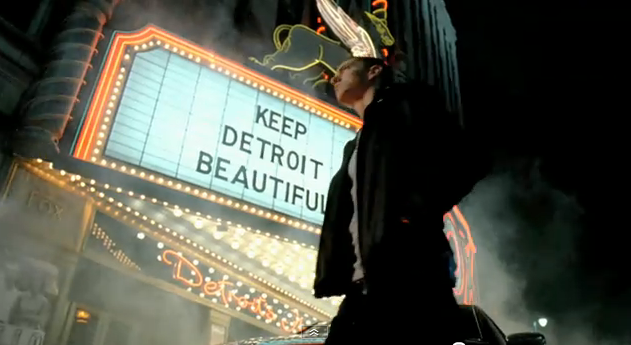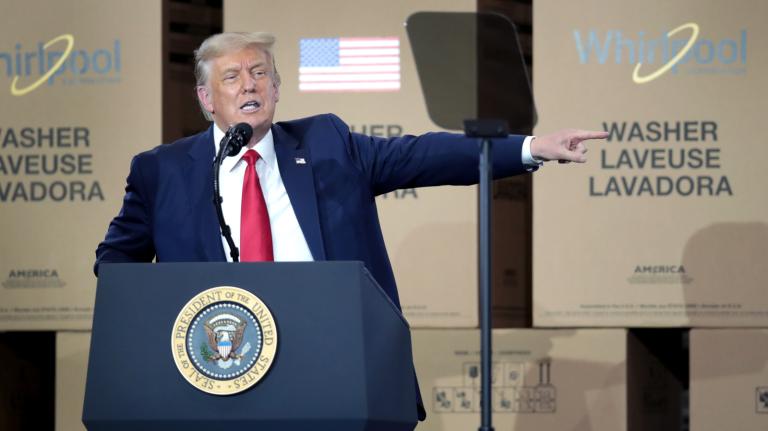The Super Bowl ad for the Chrysler 200 didn’t bother trying to sell you a car. It was selling a city, because these days, that’s what sells.
That city, of course, was Detroit. In the two-minute spot, which was cheered by Monday morning marketing quarterbacks as one of the game’s most successful, Eminem drives through the streets of the Motor City looking tough while an announcer intones, “What does a town that’s been to hell and back know about the finer things in life? Well, I’ll tell you. More than most. You, see, it’s the hottest fires that make the hardest steel.” The tagline: “Imported from Detroit.”
The video had gotten nearly 4.8 million views on YouTube as of Thursday morning. A lot of Detroit business leaders liked what the ad did for their city’s profile. The agency that made it, Wieden + Kennedy, got props from AdWeek, Entertainment Weekly, and many others.
But Bloomberg Businessweek warned that it might not do much to move the car it advertised, and also that it was risky to tie Chrysler’s image even more closely to Detroit’s:
Troubled American car brands need to get away from gritty Detroit imagery. No one needs reminding that Detroit is a city in serious trouble and that two of the Big Three would have disappeared if not for a government bailout.
Whatever you think of the ad — (“We are angry and scary. Buy shit from us,” was what transportation and planning blogger Aaron Naparstek tweeted) — you might want to brace yourself for a bunch more marketing efforts that try to capitalize on cities.
A “consumer trends firm” called Trendwatching.com has flagged “Urbanomics” in its most recent briefing as being one of the year’s top trends (others include “planned spontaneity,” if you can wrap your mind around that concept, and “eco superior products”).
Last year, Detroit was one of several cities featured in a Palladium Boots promotional web series called “Explorations.” The Detroit episode was notable for going beyond “ruin porn” to focus on the positive change happening in the city.
According to Trendwatching, cities offer a huge marketing opportunity for people who want to sell lots of stuff to the people who live in those cities — as well as visitors. “Celebrate Urban Pride” is listed as a top opportunity for folks wanting to shill stuff to “Citysumers,” as the company calls them, in a rather hideous coinage:
The hundreds of millions (and growing!) of experienced and sophisticated urbanites*, from San Francisco to Shanghai to São Paulo, who are ever more demanding and more open-minded, but also more proud, more connected, more spontaneous and more try-out-prone, eagerly snapping up a whole host of new urban goods, services, experiences, campaigns and conversations.
That asterisk? It refers you to this footnote:
To be absolutely clear, in this briefing we focus on urban consumers who have some level of disposable income. We’ll save a full briefing to examine BOTTOM OF THE URBAN PYRAMID consumption in emerging markets, which brings its own challenges (and often-overlooked opportunities) for businesses.
In other words, stay tuned and we’ll advise you on how to sell your products to people living on a dollar a day in the global ghetto as well as those who jet off for the weekend toting Louis Vuitton carry-ons.
 Trendwatching points to a few examples of marketing to urban pride, including completely useless tchotchkes — like “City in a Jar,” a collection of buttons featuring a city’s famous landmarks — and flavored vodkas:
Trendwatching points to a few examples of marketing to urban pride, including completely useless tchotchkes — like “City in a Jar,” a collection of buttons featuring a city’s famous landmarks — and flavored vodkas:
The Absolut Cities Series was first launched in New Orleans, when the brand developed a special mango and black pepper blend inspired by the city. The taste of Boston saw the brand launch a black tea and elderflower vodka that has a backdrop reminiscent of Fenway Park’s Green Monster, while 2010’s Absolut Brooklyn was a red apple and ginger flavored vodka with a Spike Lee-designed brownstone themed bottle.
Instant garbage and nauseating vodka flavors aside, when governments and the private sector scramble to market urban areas, both can trample on the cities they are touting — in effect killing the goose that lays the golden egg.
You can see it in Manhattan, which has been relentlessly promoted as a product for years by government and by privately owned media, from Seinfeld to Sex and the City to Gossip Girl. Sadly, what we have in Manhattan today is a Disneyfied city core that has lost much of its local flavor, as small retailers, artists, and working-class people are forced out by rents that only multinational corporations and the super-rich can afford.
You can also see the pattern in Istanbul, which recently finished up a year as the official “European capital of culture,” spending $3 billion and welcoming 8 million tourists. But according to an article in The Guardian, the city’s rapid growth and gentrification have produced sometimes violent tensions:
Symbolically, the final straw for the capital of culture came one evening last September when youths invaded several contemporary art galleries in the Tophane district, wielding clubs and iron bars, smashing plate glass and threatening guests at an opening. The incident reflected the resentment of local people who accused fashionable artists of consuming alcohol in public and encouraging the gentrification of the city centre….
“Istanbul is a chaotic city, now ungovernable because it has turned into a commodity. Cultural values have been sacrificed for the sake of financial profit,” says Mustafa Sönmez, a columnist on the daily Cumhuriyet.
Young people have been pushed out of the city center by rising prices, and the response by developers has been to create a kind of theme park where they can go and pretend they are living in the old Istanbul:
Some 40km from the Bosphorus a concrete replica of the straits is being built on the European side of the conurbation. Bosphorus City, much as dozens of similar projects here, targets young urbanites. The new quarter has a bridge, kitsch Ottoman villas imitating the traditional wooden yali and the inevitable fish restaurants. “Our idea is to recreate life on the shoreline, but at a more affordable price,” says one of the sales team.
Back to Detroit. Exponential growth is not exactly a problem there, in case you hadn’t heard. So at least in this phase of their history, aggressive marketing is likely a good thing.
But is the kind of image projected by the Chrysler ad doing Detroit any real favors? Aaron Renn, who blogs intelligently about the Midwest on The Urbanophile, wrote a terrific post last year on how cities can build themselves up by promoting what he refers to as “the authentic city”:
To renew our cities, we have to build on what they are, not what they aren’t. The lesson of Portland is not the physical things Portland did. The lesson of Portland is that they went their own way and did what was right for them. Other cities need to find their own paths. That doesn’t mean you can’t do something or aspire to be something you’ve never been. That’s how we grow as people and as cities….
A great city, like a great wine, has to express its terroir.
So what is Detroit’s terroir?
You could say that the Eminem ad is drawing on some of Detroit’s inherent strengths — its toughness, its grit, its reputation as a place where real people make real things out of real steel. Renn says this about the ad:
What this really shows once again is the power of brand Detroit. Is there another city in America an ad like that could have been created about? Even in a radically different style, it’s hard to imagine someone using the power of a city’s brand to sell a product in that way other than perhaps a tourist town or in a totally facile way (“We brew our beer in Milwaukee”).
You could also flip all that on its head. Toughness can be viewed as resistance to change. Grit becomes decay. The fixation on nuts and bolts manufacturing becomes over-reliance on a single industry. The auto manufacturer that glorifies Detroit in this ad has also been part of the city’s decline. (Full disclosure: my father was an executive at Chrysler in the 1980s.)
So is this “the authentic Detroit,” the one that should be marketed and promoted?
There are lots of exciting things happening in Detroit. The city recently topped the list of places with the most job growth in the tech sector (it’s a relative thing, considering how weak last year’s numbers were, but still). Entrepreneurs of all types abound, and young people — at least some of them — are beginning to see the city as a place for possibility rather than something to flee from.
I’ll put it out to you, readers, if you’ve stayed with me this far. What examples do you have of places effectively marketing themselves without self-destructing? How can a city sell itself, and how can things be sold to a city’s people, without a devolution into pandering and money-grubbing? How can our cities thrive as engines of commerce without being consumed by it?



